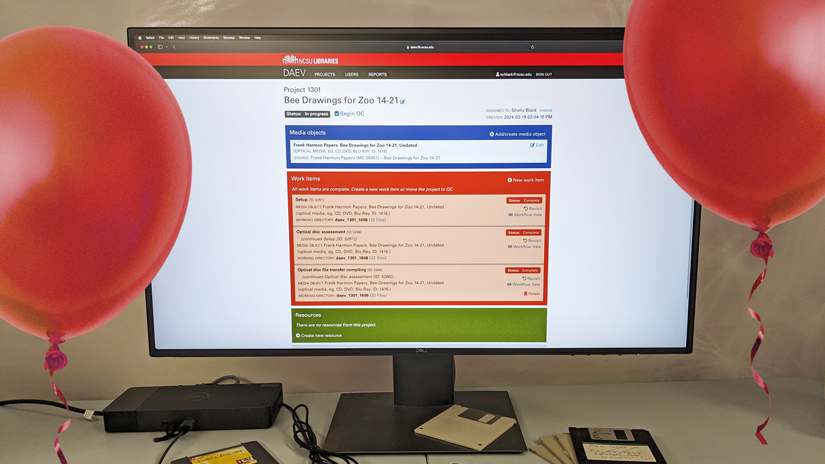
Born-Digital Reboot: DAEV 2 Launches

While all that could be heard was the humming of some computer fans and disks spinning, DAEV version 2 made its quiet launch at the end of 2023.
DAEV (Digital Assets of Enduring Value) is a web application that supports born-digital processing. DAEV was developed by Trevor Thornton in the Digital Libraries Initiatives department, and its first iteration was deployed in 2015. (Trevor built and maintains multiple SCRC and Libraries applications.) Over the years, many full-time and graduate student staff have used DAEV. In past blog posts, we explored DAEV functionality and provided a sneak peek at how version 2 would support improvements for how we assess, package, and describe born-digital materials. This version was several years in the making and involved extensive testing in a staging environment. DAEV 2 introduced many new features, which have made our lives much easier.
For example, DAEV 2 has expanded workflows for handling different legacy storage media. In the original DAEV, processors could select a workflow, such as floppy disk imaging, and DAEV guided them through the workflow by providing specific commands to run in the terminal. A new workflow in DAEV 2 is for processing disks with legacy file systems that do not mount on current operating systems. Put another way, these disks do not appear in the Mac Finder or Windows File Explorer (mounted), though the disk itself is recognized by the computer (attached). Another new workflow is for multisession optical discs. These often take the form of an audio CD that played in a stereo, but also had files one could interact with on a computer. (Anyone remember Enhanced CDs?)
Another DAEV 2 feature is automated ingest into preservation storage. Previously, materials that were processed and passed quality control required a combination of manual and scripted tasks for transfer to local and geographically distributed preservation storage. In the new version, once a user indicates that a project has passed quality control, DAEV initiates ingest. This step is conducive to more efficient quality control, ensuring that born-digital materials are sent to long-term storage sooner.
Other automation occurs thanks to the integration of DAEV with ArchivesSpace, the third-party software we use to create and store descriptive metadata that becomes the contents of a collection guide. Each component of a collection, such as files from a floppy disk, will have an archival object record in ArchivesSpace. After DAEV triggers preservation ingest, it creates a digital object record, which represents digital assets, and associates that with the archival object record. DAEV also writes this “Conditions Governing Access” note to the archival object record: “Access to digital copies will be provided for use in the SCRC Reading Room upon request.” In the past, processors had to manually add that note.
These are just a few examples of new enhancements. Stay tuned for future blog posts on how we are using DAEV 2!
If you have any questions or are interested in viewing Special Collections materials, please contact us at library_specialcollections@ncsu.edu or submit a request online. The Special Collections Research Center is open by appointment only. Appointments are available Monday–Friday, 9am–6pm and Saturday, 1pm–5pm. Requests for a Saturday appointment must be received no later than Tuesday of the same week.